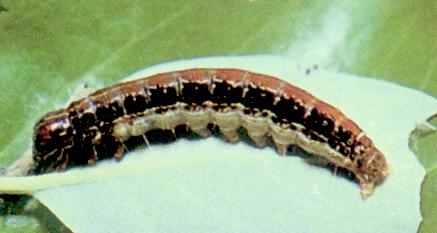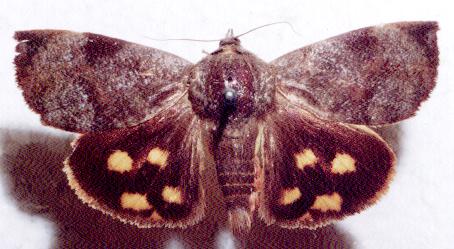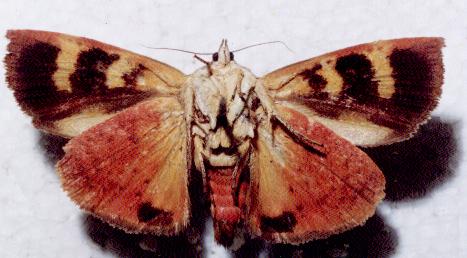
| Teak Defoliator (one synonym : Aenigma mirificum Strecker, 1876) HYBLAEIDAE, PYRALOIDEA | (donherbisonevans@yahoo.com) and Stella Crossley |

(Photo: courtesy of Ian F.B. Common
from:
Moths of Australia)

| Teak Defoliator (one synonym : Aenigma mirificum Strecker, 1876) HYBLAEIDAE, PYRALOIDEA | (donherbisonevans@yahoo.com) and Stella Crossley |

(Photo: courtesy of Ian F.B. Common
from:
Moths of Australia)
The Caterpillars of this species are brown with a pair of narrow yellow lines along each side enclosing a dark brown band. The caterpillar is a pest overseas on :
and they also feed on other trees such as:
The eggs are laid on the undersides of the leaves. The caterpillar cuts a semicircular piece of leaf and folds or rolls it over to form a shelter. The mature Caterpillar often lives in this shelter by day, and feeds nocturnally.

The adult moth has a wing span of about 4 cms. The forewings are a variable blotchy brown, sometimes with a dark spot near the middle. The hindwings are brown, each with several yellow spots.

Underneath, the forewings are brown with two yellow marks on the costa under each forewing, and orange under each hindwing with a dark mark under the tornus.
The eggs are laid singly, on the underside of young foodplant leaves, often near the central vein.
The species is endemic across south-east Asia, including
The species appears to migrate with the Monsoon winds. It has recently been reported Central America and Africa, including :
It also occurs in Australia in
Efforts are being made to control the pest using :
although these may be of little value given the migratory behaviour of the moths.

Further reading :
M.W.Baksha and M.J. Crawley,
Population dynamics of teak defoliator, Hyblaea puera Cram.
(Lep., Hyblaeidae) in teak plantations of Bangladesh,
Journal of Applied Entomology,
Volume 122, no. 2-3 (1998) pp. 79-83
Ian F.B. Common,
Moths of Australia,
Melbourne University Press, 1990, pp. 334, 336-337.
Pieter Cramer,
Uitlandsche kapellen voorkomende in de drie waereld-deelen,
Amsterdam Baalde, vol. 2 (1777), pp. 10-11, and also
Plate 103, figs. D,E.
S. Lakanavichian and B. Napompeth,
Ecological study on teak defoliators, Hyblaea puera
and Eutectona machaeralis in Thailand,
Proceedings IUFRO Workshop on Pests and Diseases of Forest Plantations,
Bangkok (Thailand), 5-11 Jun 1988,
Chaweewan Hutacharern, K.G. MacDicken, M.H.Ivory, and K.S.S. Nair (eds.),
International Union of Forestry Research Organizations, Vienna (Austria),
Royal Forest Department, Bangkok (Thailand), 1990, p. 155-166.
K.S.S. Nair and V.V. Sudheendrakumar,
The teak defoliator, Hyblaea puera:
Defoliation dynamics and evidence for short-range migration of moths,
Proceedings of the Indian Academy of Sciences (Animal Sciences),
Volume 95, no. 1 (1986), pp. 7-21.
 caterpillar |  butterflies |  Lepidoptera |  moths |  caterpillar |
(updated 19 May 2011, 29 June 2025)